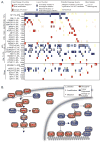Exome sequencing of desmoplastic melanoma identifies recurrent NFKBIE promoter mutations and diverse activating mutations in the MAPK pathway
- PMID: 26343386
- PMCID: PMC4589486
- DOI: 10.1038/ng.3382
Exome sequencing of desmoplastic melanoma identifies recurrent NFKBIE promoter mutations and diverse activating mutations in the MAPK pathway
Abstract
Desmoplastic melanoma is an uncommon variant of melanoma with sarcomatous histology, distinct clinical behavior and unknown pathogenesis. We performed low-coverage genome and high-coverage exome sequencing of 20 desmoplastic melanomas, followed by targeted sequencing of 293 genes in a validation cohort of 42 cases. A high mutation burden (median of 62 mutations/Mb) ranked desmoplastic melanoma among the most highly mutated cancers. Mutation patterns strongly implicate ultraviolet radiation as the dominant mutagen, indicating a superficially located cell of origin. Newly identified alterations included recurrent promoter mutations of NFKBIE, encoding NF-κB inhibitor ɛ (IκBɛ), in 14.5% of samples. Common oncogenic mutations in melanomas, in particular in BRAF (encoding p.Val600Glu) and NRAS (encoding p.Gln61Lys or p.Gln61Arg), were absent. Instead, other genetic alterations known to activate the MAPK and PI3K signaling cascades were identified in 73% of samples, affecting NF1, CBL, ERBB2, MAP2K1, MAP3K1, BRAF, EGFR, PTPN11, MET, RAC1, SOS2, NRAS and PIK3CA, some of which are candidates for targeted therapies.
Figures





Comment in
-
Desmoplastic melanoma: C>Ts and NF-κB.Pigment Cell Melanoma Res. 2016 Mar;29(2):120-1. doi: 10.1111/pcmr.12451. Epub 2016 Jan 20. Pigment Cell Melanoma Res. 2016. PMID: 26663830 Free PMC article. No abstract available.
References
Publication types
MeSH terms
Substances
Associated data
- Actions
- dbGaP/PHS000977.V1.P1
Grants and funding
LinkOut - more resources
Full Text Sources
Other Literature Sources
Medical
Molecular Biology Databases
Research Materials
Miscellaneous

